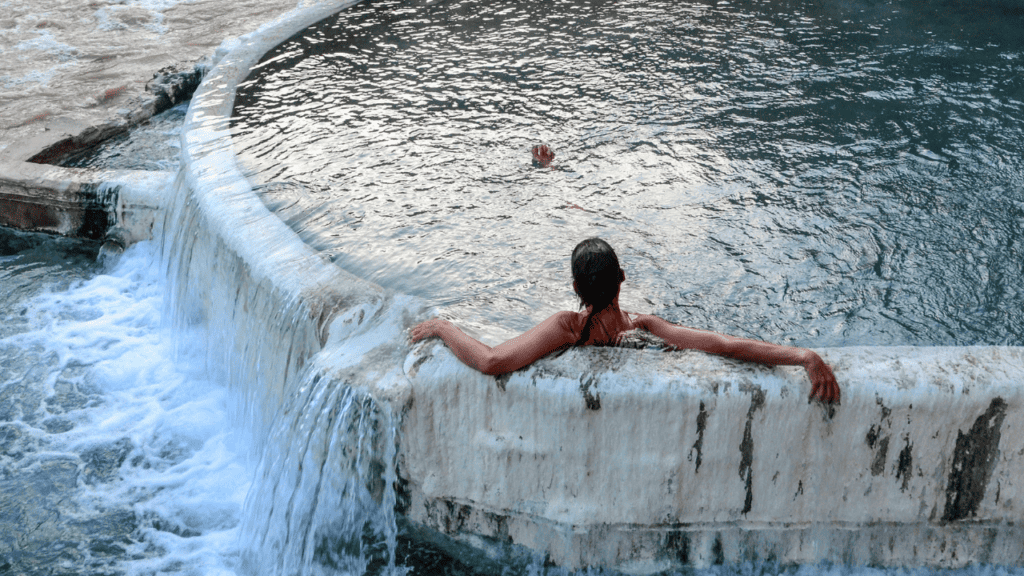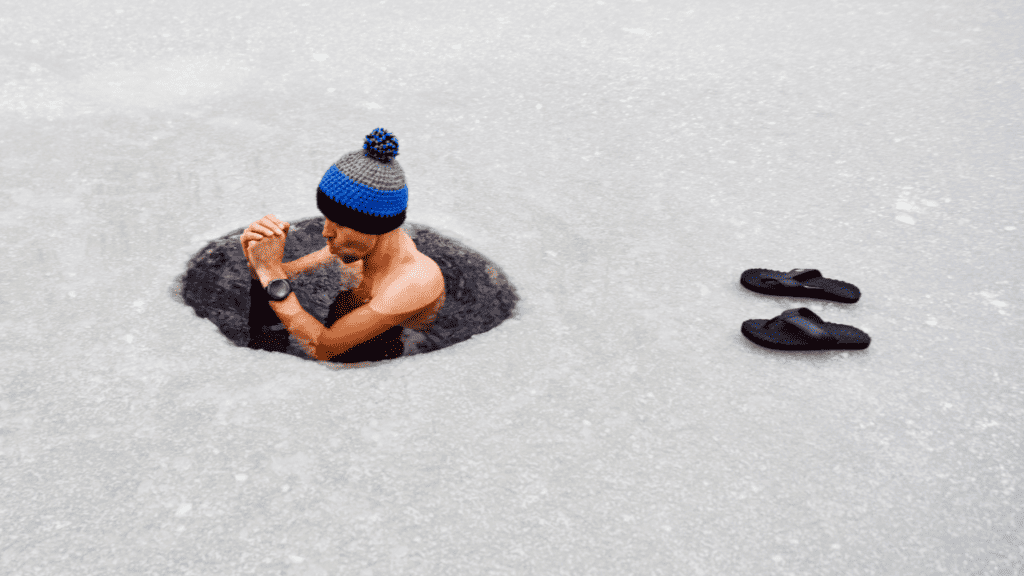Our website is supported by our readers. We sometimes earn a commission when you click through the affiliate links on our website at no extra cost to you.
Cold Plunge, once considered an extreme practice only done by maniacal individuals pushing their limits has now grown into a mainstream phenomenon. It seems everyone from high-profile athletes to social media influencers are raving about them lately. But despite the fanfare, does the science of cold plunge check out? That’s what we want to find out. After all, why put yourself through icy misery if there are no proven benefits?
Definition of Cold Plunge
Cold plunge refers to the act of immersing oneself in cold water for a relatively short duration of time. Commercial cold plunges are numerous, but hopping in one of nature’s freezing bodies of water counts too. The total duration of a cold plunge can vary but is typically kept within the range of a few minutes.
According to Dr. Tracy Zaslow, a sports medicine physician, “While there is not an exact, one-size-fits-all definition for cold plunging, the water tends to be between 50 and 59 degrees Fahrenheit and is usually done for no more than 10 or 15 minutes at a time.”
The primary goal behind a cold plunge is not merely endurance or torture; rather, it aims to harness the remarkable physiological and psychological effects that result from subjecting our bodies to extreme cold for short bursts of time. While initially challenging both mentally and physically, these icy encounters trigger an array of responses within our bodies that lead to various health benefits over time.
The Science Behind Cold Plunge
Now before we explain the how, when, and why of cold plunge, first we need to understand the what. What cascade of physiological events is happening in the body when you voluntarily (or not) hop in a freezing tub of ice?

Thermoregulation and its Importance to the Human Body
Thermoregulation is the body’s ability to maintain a stable internal temperature. It is a vital process that ensures our bodily functions operate optimally. Our bodies are finely tuned machines, constantly working to keep us within a narrow range of temperatures.
This delicate balance is crucial because even slight deviations from the optimal temperature can have detrimental effects on our health. The human body functions best at around 98.6°F (37°C), and any significant fluctuation beyond this range can lead to various complications.
Homeostasis and Maintaining Optimal Body Temperature
Homeostasis, the body’s innate drive for stability, plays a key role in maintaining optimal body temperature. Through a series of intricate processes, the body strives to counteract external temperature changes and restore equilibrium internally. When subjected to cold temperatures during a plunge, the body instinctively responds by increasing heat production through mechanisms like shivering.
Achieving homeostasis relies on various physiological mechanisms that ensure our internal environment remains balanced despite external influences.
Through these adaptive responses, our bodies maintain stable temperatures essential for sustaining metabolic reactions and overall well-being.

Role of the Hypothalamus in Regulating Body Temperature
The hypothalamus, a small but mighty region within our brain, acts as the command center for regulating body temperature. It serves as an interface between our nervous system and endocrine system while orchestrating numerous bodily functions—including thermoregulation—all in an effort to maintain homeostasis. When exposed to cold stimuli during a plunge or any other cold exposure modality, the hypothalamus detects the temperature changes and initiates a series of events to ensure our body can cope.
By activating the sympathetic nervous system, the hypothalamus triggers vasoconstriction, causing blood vessels near the skin’s surface to narrow. This constriction helps retain heat in vital organs and ensures essential bodily functions continue unimpeded.
Additionally, through its communication with other brain regions, the hypothalamus stimulates the release of endorphins and other feel-good hormones during cold exposure. These neurotransmitters not only contribute to pain relief but also promote an enhanced sense of well-being and relaxation.
Cold plunging harnesses these intricate mechanisms of thermoregulation, highlighting how our bodies adapt to extreme temperatures for both physical and mental benefits. Understanding these processes allows us to appreciate why cold exposure can be such a powerful tool in optimizing our overall health and well-being.
How to Cold Plunge: Techniques and Methods
Traditional methods from different cultures around the world

Cold plunging has been practiced for centuries in various cultures, each with its own unique approach. One such method is the Scandinavian ice bath, known as “Isbading.” Originating from Nordic countries, Isbading involves immersing oneself in freezing water or rolling in the snow after a sauna session.
This practice is believed to stimulate blood circulation and invigorate the body. The shock of the cold water against the warm skin creates a refreshing sensation that promotes relaxation and rejuvenation.
Another traditional method of cold immersion comes from Japan, known as “Misogi.” This ancient practice involves standing under a waterfall or submerging oneself in icy mountain streams or lakes. The Japanese believe that Misogi strengthens both physical and mental resilience.
It is believed to improve endurance, boost immune function, and promote overall well-being. The meditative aspect of this practice also contributes to its popularity among those seeking clarity of mind.
Modern approaches to cold plunging
In recent years, modern technologies have introduced new ways to experience the benefits of cold plunging without relying solely on natural bodies of water. Water chillers now make it possible to pump near-freezing water in any tub or portable ice bath.
Nowadays your cold plunge options are innumerable it seems. From high-end custom builds to simple PVC pods, taking an ice bath has never been more accessible and available.
Some cold plunges even resemble a standard bathtub but with fancy lights, built-in UV sanitation, and water filters.

Overall, there is no shortage of techniques and methods when it comes to cold plunging. Whether you seek authenticity through traditional practices or prefer modern innovations like ice baths, finding the approach that best suits your preferences and goals is essential in reaping the benefits of this invigorating practice.
When to Cold Plunge: Timing Strategies for Maximum Impact
Pre-workout vs. post-workout cold plunges
Submerging oneself in icy water before or after exercise can have distinct effects on performance, recovery, and muscle soreness. Pre-workout cold plunges are gaining popularity among athletes and fitness enthusiasts due to their potential to enhance performance.
Cold Plunge Pre-Workout
Plunging into cold water prior to exercise is believed to increase alertness, stimulate the sympathetic nervous system, and activate brown fat, a type of fat tissue that generates heat by burning calories. This can lead to improved energy levels, heightened focus, and enhanced muscular function during physical activity.

Cold Plunge Post-Workout
On the other hand, post-workout cold plunges have gained recognition for their role in aiding recovery. Intense exercise induces muscle damage and inflammation, resulting in delayed onset muscle soreness (DOMS).
Cold exposure immediately after exercise has been shown to reduce inflammation by modulating cytokines and decreasing swelling. Moreover, it may help decrease pain sensitivity and alleviate muscle soreness associated with DOMS.
However, here’s the big BUT. If your physical goal in working out is to grow muscle and stimulate hypertrophy, experts agree that you should wait to cold plunge at a minimum of 4 hours post-workout.
Cold plunge as a morning ritual or bedtime routine
In addition to its impact on workouts, incorporating cold plunges into one’s daily routine as either a morning ritual or bedtime routine can have significant benefits on energy levels, mental clarity, and sleep quality.
Cold plunge in the morning
Starting the day with a cold plunge can provide an invigorating jolt that wakes up the body and mind.
The sudden exposure to icy water activates the sympathetic nervous system, leading to increased alertness and improved cognitive function throughout the day. Additionally, the release of endorphins during cold immersion contributes to elevated mood levels which can set a positive tone for the day ahead.
Cold plunge before bed
Conversely, taking a cold plunge before bedtime offers unique advantages for winding down and improving sleep quality. Cooling down the body’s core temperature triggers natural physiological reactions that promote sleep onset.
The drop in body temperature after a cold plunge signals the body to release melatonin, the hormone responsible for regulating sleep-wake cycles. This can lead to a faster onset of sleep, more restful slumber, and even help combat insomnia.
“Nearly every article I’ve read on improving sleep mentions hot baths or showers. But that does nothing. To sleep deeply you want your core temperature to be as low as possible. So a cold dip works a thousand times better. Think about how you feel after swimming in a frigid lake or ocean. You’re napping an hour or two later.”
Jason Ferruggia is a highly sought after, world renowned strength & conditioning specialist
Experimenting with different timings allows individuals to personalize their cold plunge experience according to their unique needs and goals.
Why Cold Plunging Works: The Physiological Effects Explained
Vasoconstriction and increased blood flow after exposure
When subjected to cold water immersion, the body initiates a response known as vasoconstriction. This physiological process refers to the narrowing of blood vessels, which reduces blood flow to the extremities and redirects it towards vital organs in an effort to maintain core body temperature.
As a result, this redirection increases blood circulation and oxygen delivery to vital organs, including the heart and brain. Additionally, vasoconstriction promotes efficient nutrient transport and waste removal within the body.
Following cold exposure, when individuals exit the cold plunge or ice bath, there is a subsequent phenomenon called vasodilation. This mechanism involves the widening of blood vessels in response to rewarming.
Vasodilation helps restore normal blood flow by expanding peripheral blood vessels and enhancing oxygen supply to tissues previously constricted during cold immersion. This process aids in reducing muscle tension, alleviating pain, and facilitating tissue repair.
Reduced inflammation through modulation of cytokines

Cold plunging has been shown to have anti-inflammatory effects on the body by modulating cytokine levels. Cytokines are small proteins secreted by immune cells that regulate inflammation and immune responses within the body. When exposed to cold temperatures during a plunge or cryotherapy session, cytokine activity is altered, resulting in a reduction in pro-inflammatory cytokines such as interleukin-6 (IL-6) and tumor necrosis factor-alpha (TNF-α).
This modulation of cytokines plays a crucial role in minimizing inflammation as excessive or chronic inflammation can lead to various health issues such as joint pain, cardiovascular diseases, and metabolic disorders. By decreasing pro-inflammatory markers while increasing anti-inflammatory cytokines like IL-10 through regular cold plunging sessions or cryotherapy treatments, individuals may experience enhanced recovery, reduced muscle soreness, and improved overall well-being.
Improved immune function through activation of brown fat
Cold exposure stimulates the activation of brown adipose tissue (BAT), commonly known as brown fat. Unlike white fat, which stores energy, brown fat generates heat by burning calories to maintain body temperature. Cold plunging or cold exposure in general can activate brown fat due to the need for increased thermogenesis.
The activation of brown fat through cold immersion has been associated with numerous benefits, including enhanced metabolic rate and improved insulin sensitivity. Furthermore, studies suggest that increased BAT activity may have a positive impact on immune function.
Cold-induced activation of BAT leads to the release of adipokines such as adiponectin, which plays a role in regulating inflammation and improving overall immune response. Cold plunging elicits various physiological effects that contribute to its therapeutic benefits.
Activating brown fat through cold exposure triggers metabolic changes and promotes an optimized immune response. By understanding these mechanisms, individuals can appreciate the scientific basis behind the efficacy of cold plunging as a holistic wellness practice.
The Psychological Aspect: Mental Health Benefits Of Cold Plunging

Stress reduction through Cold Plunging: Unlocking Tranquility
One cannot underestimate the power of cold plunging when it comes to stress reduction. The shocking burst of cold water against your skin triggers a series of physiological responses that translate into a remarkable sense of tranquility. As you immerse yourself in the icy depths, your body’s sympathetic nervous system goes into overdrive, releasing adrenaline and norepinephrine.
These chemicals not only sharpen your focus but also alleviate symptoms of anxiety and depression, providing you with an immediate sense of calmness. Furthermore, cold plunging activates the parasympathetic nervous system, which is responsible for bringing our bodies back to a state of rest and relaxation.
This activation helps counteract the effects of chronic stress by reducing cortisol levels and promoting an overall feeling of well-being. Regular cold plunge sessions can lead to long-term resilience against stress and promote mental clarity in our daily lives.

A Refreshing Dip for Mental Clarity
Beyond stress reduction, cold plunging has been praised for its ability to enhance mental clarity and improve cognitive function. The intense exposure to icy temperatures stimulates blood circulation throughout the body, including the brain.
This increased blood flow brings a rush of oxygen and nutrients to our neural networks, resulting in heightened alertness and improved mental performance. Moreover, cold plunging triggers the release of endorphins – nature’s very own mood-enhancing chemicals – creating an immediate sense of euphoria that can last long after you step out from the frigid waters.
This natural high not only boosts mood but also improves focus, memory retention, and creativity. So next time you’re facing writer’s block or struggling with a challenging task at work or school, take a refreshing dip into icy waters to unlock your full cognitive potential.
Conclusion
Cold plunging, with its remarkable physiological and psychological effects, has emerged as a powerful tool for promoting mental well-being. Whether it’s stress reduction, enhanced mental clarity, or an overall sense of tranquility, the benefits of immersing oneself in icy waters are undeniable.
By embracing the science behind cold plunge and incorporating it into our daily routines, we can tap into a profound source of rejuvenation for both mind and body. So dare to plunge into the depths of icy waters and discover a world of holistic wellness that awaits you.
The authors and editors that comprise the Recovatech Team have 20+ years of combined experience and knowledge covering the topics of strength, fitness, and recovery. We are impassioned in our pursuit of presenting the most up-to-date information on strength training, cardio fitness, physical rehab, functional movement, nutrition, workout recovery, and best-in-class reviews. Should you feel inclined, please reach out to us at admin[at]recovatech.com.

